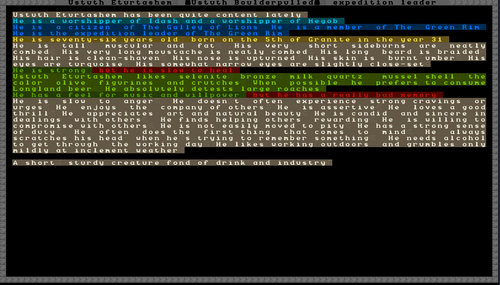- v50 information can now be added to pages in the main namespace. v0.47 information can still be found in the DF2014 namespace. See here for more details on the new versioning policy.
- Use this page to report any issues related to the migration.
v0.34:Thoughts and preferences
| This article is about an older version of DF. |
The most detailed screen in the profile is the thoughts and preferences screen, accessible with u-v-Enter or v-z-Enter. It gives you a detailed breakdown of your dwarves' happiness and thoughts, familial status, civilization membership, age and date of birth, physical descriptors (and wounds), physical attributes, preferences, mental attributes, and personality traits, in that order. All dwarves have two pieces of their profiles in common: "He/she needs alcohol to get through the working day" (indicating that all dwarves are alcoholics), amongst their personality traits, and "A short sturdy creature fond of work and industry" at the end of the screen (this is actually the dwarf's tagline, and will appear at the beginning for all other creatures). Non-citizens have profiles too, although these are far less detailed, only giving physical characteristics, wounds, and their tagline.
Thoughts[edit]
This first section is in white, and will state the name of the dwarf and then their overall status (Ecstatic/Happy/Content/Unhappy/Very unhappy/Miserable). It will then list their recent thoughts, providing an overview of what's making them happy or unhappy.
Familial status[edit]
Family relationships are special in that they get special mention on the dwarves' thoughts and preferences, in light blue. This section will list spouses, children, and parents, in that order. It will also include any objects of worship.
Civilization membership[edit]
This section will list first the civilizations that the dwarf has entered or left, and at the end will give their date of arrival at your fortress. This section is static, and most important when hunting for vampires, which will almost always have excessively long (10+) civilization memberships. Most dwarves have at most five items on this screen, which is in blue.
Age and date of birth[edit]
This section is in yellow, and is fairly self-explanatory. Age is mostly irrelevant, but will tell you how close babies are to becoming children, children to adults, and how long it is before elderly dwarves pass away from old age (your fortress has to be very old for that to start to happen, however).
In short history worlds, you may encounter dwarves that were created along with the world. Since they were created as adults, they are technically younger than they look. Thus you will get the "has the appearance of one who is X years old" message when you check their age. They also tend to be highly experienced and hold high positions. As these are also common traits of vampires, it's possible that you might end up wasting a perfectly good dwarf. A "quarantine" room, with beds, food, and drink can help you determine which is the case. Wall them in, and check periodically. If the food, drink or beds are never used, you know you are dealing with un-undead.
See here for more information.
Physical description[edit]
This section, in white, gives a physical description of the dwarf, and will be the only thing displayed for a non-dwarf. Physical properties are only important in dwarves for combat (more muscle and fat means more mass for fighting and an ability to wield bigger weapons), but is an important variable in butchering returns as well as affecting how well other creatures fight. Physical characteristics are heavily influenced by dwarven genetics.
In addition, any external wounds will be noted in red (open), brown (bruise or scar), or gray (missing body parts). This is the best way to get an at-a-glace of a creature's wounds, giving a better description then the view window's wounds screen outside of internal wounds requiring surgery. Serious injuries will still need diagnosis before treatment, however.
Physical attributes[edit]
Physical attributes affect how well your dwarves are able to do something, and are trained by performing jobs that exercise that attribute. These are strength (used in combat, mining, and woodcutting), agility (used when running), toughness (used in combat), endurance (used when working while tired and pump operating), recuperation (used when healing wounds), and disease resistance (used when healing from syndromes). Above-average attributes will be in green, below-average in red. Average results will not be reported.
Preferences[edit]
Dwarves like certain materials, colors, animals, and brews of alcohol, and detest certain vermin. Being exposed to these likes or dislikes will give them a higher-then-normal chance of getting a higher-then-normal positive or negative thought, respectively. This comes in handy most when designating dwarves for duties, as dwarves love to work with materials and creatures of their preferences, and will produce higher quality goods as a result. Being able to outfit nobles' quarters with classy preferable items is a perk, too. This section is in green again.
Mental attributes[edit]
Mental attributes work in much the same way as physical attributes, are listed in the same way, and come in a much greater variety. Most effect how your dwarves are able to do their jobs, as certain mental abilities are important in certain trades.
Personality traits[edit]
A dwarf's personality traits affect a lot of things. A nervous wreck of a wood cutter would be very quick to become unhappy if they are unlucky enough to be ambushed by a foe while felling a tree, even if they come out on top in the ensuing encounter. Some are truly meaningless ("she always takes a deep breath whenever she is surprised"), but many affect how the dwarf works and relates to others. Affects how and what social skills they train.
